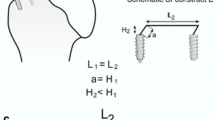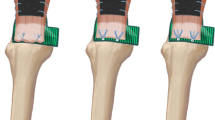Abstract
Purpose
Re-establishment of the native footprint during rotator cuff repair is important for maximizing healing potential and fixation strength. The purpose of this study was to evaluate the contact area, contact pressure, stiffness and tensile strength of a new single-row cruciate suture repair and to compare these results to those of the Mason-Allen, double-row and transosseous repairs.
Methods
Infraspinatus tendons from fifty-six lamb shoulders were harvested and randomly assigned to cruciate suture, Mason-Allen, double-row and transosseous repair groups. Repairs were performed over pressure-sensitive film and footprint contact area and pressure measured. Repaired tendon specimens were also loaded in uniaxial tension, and ultimate tensile strength and stiffness measured.
Results
The cruciate suture repair established significantly greater footprint contact area compared to the Mason-Allen repair (mean difference = 101 mm2, p = 0.003). The ultimate tensile strength and stiffness of the double-row repair was significantly higher than that of all other repair groups (p < 0.05). The average footprint contact pressure of the cruciate suture repair (0.78 MPa) was similar to that of the Mason-Allen (0.74 MPa) and double-row repairs (0.79 MPa). The ultimate tensile strength of the cruciate suture repair was significantly greater than that of the transosseous repair (mean difference 62.4 N, p = 0.002).
Conclusion
The cruciate suture repair may improve strength and healing at the repaired tendon rotator cuff insertion relative to other single-row repair techniques. It may represent a faster, easier and more cost-effective alternative to double-row repairs.



Similar content being viewed by others
References
Apreleva M, Ozbaydar M, Fitzgibbons PG, Warner JJ (2002) Rotator cuff tears: the effect of the reconstruction method on three-dimensional repair site area. Arthroscopy 18(5):519–526
Baleani M, Ohman C, Guandalini L, Rotini R, Giavaresi G, Traina F, Viceconti M (2006) Comparative study of different tendon grasping techniques for arthroscopic repair of the rotator cuff. Clin Biomech 21(8):799–803
Baums MH, Buchhorn GH, Spahn G, Poppendieck B, Schultz W, Klinger HM (2008) Biomechanical characteristics of single-row repair in comparison to double-row repair with consideration of the suture configuration and suture material. Knee Surg Sports Traumatol Arthrosc 16(11):1052–1060
Baums MH, Spahn G, Steckel H, Fischer A, Schultz W, Klinger HM (2009) Comparative evaluation of the tendon-bone interface contact pressure in different single- versus double-row suture anchor repair techniques. Knee Surg Sports Traumatol Arthrosc 17(12):1466–1472
Bishop J, Klepps S, Lo IK, Bird J, Gladstone JN, Flatow EL (2006) Cuff integrity after arthroscopic versus open rotator cuff repair: a prospective study. J Shoulder Elb Surg 15(3):290–299
Burks RT, Crim J, Brown N, Fink B, Greis PE (2009) A prospective randomized clinical trial comparing arthroscopic single- and double-row rotator cuff repair: magnetic resonance imaging and early clinical evaluation. Am J Sports Med 37(4):674–682
Cho NS, Yi JW, Lee BG, Rhee YG (2010) Retear patterns after arthroscopic rotator cuff repair: single-row versus suture bridge technique. Am J Sports Med 38(4):664–671
Demirhan M, Atalar AC, Kilicoglu O (2003) Primary fixation strength of rotator cuff repair techniques: a comparative study. Arthroscopy 19(6):572–576
Franceschi F, Ruzzini L, Longo UG, Martina FM, Zobel BB, Maffulli N, Denaro V (2007) Equivalent clinical results of arthroscopic single-row and double-row suture anchor repair for rotator cuff tears: a randomized controlled trial. Am J Sports Med 35(8):1254–1260
Galatz LM, Ball CM, Teefey SA, Middleton WD, Yamaguchi K (2004) The outcome and repair integrity of completely arthroscopically repaired large and massive rotator cuff tears. J Bone Jt Surg Am 86-A(2):219–224
Gazielly DF, Gleyze P, Montagnon C (1994) Functional and anatomical results after rotator cuff repair. Clin Orthop Relat Res 304:43–53
Gerber C, Schneeberger AG, Beck M, Schlegel U (1994) Mechanical strength of repairs of the rotator cuff. J Bone Jt Surg Br 76(3):371–380
Gerber C, Schneeberger AG, Perren SM, Nyffeler RW (1999) Experimental rotator cuff repair. A preliminary study. J Bone Jt Surg Am 81(9):1281–1290
Hapa O, Barber FA, Sunbuloglu E, Kocabey Y, Sarkalkan N, Baysal G (2011) Tendon-grasping strength of various suture configurations for rotator cuff repair. Knee Surg Sports Traumatol Arthrosc 19(10):1749–1754
Harryman D T II, Mack LA, Wang KY, Jackins SE, Richardson ML, Matsen F A III (1991) Repairs of the rotator cuff. Correlation of functional results with integrity of the cuff. J Bone Jt Surg Am 73(7):982–989
Kim DH, Elattrache NS, Tibone JE, Jun BJ, DeLaMora SN, Kvitne RS, Lee TQ (2006) Biomechanical comparison of a single-row versus double-row suture anchor technique for rotator cuff repair. Am J Sports Med 34(3):407–414
Kim JR, Cho YS, Ryu KJ, Kim JH (2012) Clinical and radiographic outcomes after arthroscopic repair of massive rotator cuff tears using a suture bridge technique: assessment of repair integrity on magnetic resonance imaging. Am J Sports Med 40(4):786–793
Liggins AB, Hardie WR, Finlay JB (1995) The spatial and pressure resolution of fuji pressure-sensitive film. Exp Mech 35(2):166–173
Lo IK, Burkhart SS (2003) Double-row arthroscopic rotator cuff repair: re-establishing the footprint of the rotator cuff. Arthroscopy 19(9):1035–1042
Lorbach O, Bachelier F, Vees J, Kohn D, Pape D (2008) Cyclic loading of rotator cuff reconstructions: single-row repair with modified suture configurations versus double-row repair. Am J Sports Med 36(8):1504–1510
Ma CB, Comerford L, Wilson J, Puttlitz CM (2006) Biomechanical evaluation of arthroscopic rotator cuff repairs: double-row compared with single-row fixation. J Bone Jt Surg Am 88(2):403–410
Maguire M, Goldberg J, Bokor D, Bertollo N, Pelletier MH, Harper W, Walsh WR (2011) Biomechanical evaluation of four different transosseous-equivalent/suture bridge rotator cuff repairs. Knee Surg Sports Traumatol Arthrosc 19(9):1582–1587
Mazzocca AD, Millett PJ, Guanche CA, Santangelo SA, Arciero RA (2005) Arthroscopic single-row versus double-row suture anchor rotator cuff repair. Am J Sports Med 33(12):1861–1868
Meier SW, Meier JD (2006) Rotator cuff repair: the effect of double-row fixation on three-dimensional repair site. J Shoulder Elb Surg 15(6):691–696
Nelson CO, Sileo MJ, Grossman MG, Serra-Hsu F (2008) Single-row modified Mason-Allen versus double-row arthroscopic rotator cuff repair: a biomechanical and surface area comparison. Arthroscopy 24(8):941–948
Park MC, Cadet ER, Levine WN, Bigliani LU, Ahmad CS (2005) Tendon-to-bone pressure distributions at a repaired rotator cuff footprint using transosseous suture and suture anchor fixation techniques. Am J Sports Med 33(8):1154–1159
Park MC, Elattrache NS, Ahmad CS, Tibone JE (2006) “Transosseous-equivalent” rotator cuff repair technique. Arthroscopy 22(12):1360.e1–1360.e5
Park MC, ElAttrache NS, Tibone JE, Ahmad CS, Jun BJ, Lee TQ (2007) Part I: Footprint contact characteristics for a transosseous-equivalent rotator cuff repair technique compared with a double-row repair technique. J Shoulder Elb Surg 16(4):461–468
Park MC, Tibone JE, ElAttrache NS, Ahmad CS, Jun BJ, Lee TQ (2007) Part II: Biomechanical assessment for a footprint-restoring transosseous-equivalent rotator cuff repair technique compared with a double-row repair technique. J Shoulder Elb Surg 16(4):469–476
Reardon DJ, Maffulli N (2007) Clinical evidence shows no difference between single- and double-row repair for rotator cuff tears. Arthroscopy 23(6):670–673
Reed SC, Glossop N, Ogilvie-Harris DJ (1996) Full-thickness rotator cuff tears. A biomechanical comparison of suture versus bone anchor techniques. Am J Sports Med 24(1):46–48
Scheibel MT, Habermeyer P (2003) A modified Mason-Allen technique for rotator cuff repair using suture anchors. Arthroscopy 19(3):330–333
Tuoheti Y, Itoi E, Yamamoto N, Seki N, Abe H, Minagawa H, Okada K, Shimada Y (2005) Contact area, contact pressure, and pressure patterns of the tendon-bone interface after rotator cuff repair. Am J Sports Med 33(12):1869–1874
Author information
Authors and Affiliations
Corresponding author
Rights and permissions
About this article
Cite this article
Caldow, J., Richardson, M., Balakrishnan, S. et al. A cruciate suture technique for rotator cuff repair. Knee Surg Sports Traumatol Arthrosc 23, 619–626 (2015). https://doi.org/10.1007/s00167-014-3474-7
Received:
Accepted:
Published:
Issue Date:
DOI: https://doi.org/10.1007/s00167-014-3474-7




